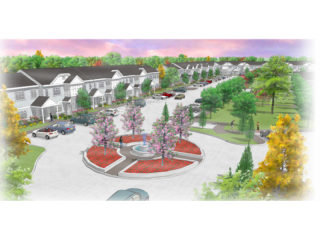The developer of Highland Green, a 117-unit townhouse project planned for a site in Melville, has secured the financing needed to move forward, officials said.
Calling it Long Island’s first limited equity cooperative, Huntington Town Supervisor Frank Petrone said he expects construction for the Ruland Road project to begin this spring.
“This is a major step toward building the first example of what could become an important affordable housing option for Long Island,” Petrone said.
D&F Development Group, the project’s developer, obtained financing from a variety of sources, including the New York State Housing Finance Agency, the New York State Affordable Housing Corporation, the Suffolk County Department of Economic Development and Planning and the Long Island Housing Partnership, which will administer the lottery for the units in cooperation with the developer and the town. Private banks are also involved.
Of the 117 units, 93 will be available to persons whose income does not exceed 60 percent of the area median income ($44,150 for an individual, $63,050 for a family of four). The remaining 24 units will be available to those whose income does not exceed 80 percent of the median ($58,850 for an individual and $84,100 for a family of four). Ten percent of the units will have preference for certain veterans, 10 percent will be for handicapped persons and four percent will be for the hearing or visually impaired. The development will have 72 one-bedroom units, 39 two-bedroom units and six three-bedroom units.
Limited equity cooperatives are designed to provide affordable home ownership to qualified income eligible residents by allowing residents to purchase shares in the development for a minimal amount of equity investment.
In the case of this co-op, purchasers will pay the equivalent of two months’ maintenance as a down-payment, and there is no mortgage or other type of financing required for the purchaser. For the one-bedroom units, it is anticipated that the down-payment would be between $1,880 and $2,600, depending on the income level, and the monthly maintenance charges would be between $940 and $1,300.
Residents will build equity because part of their monthly payments will go towards the reduction of a $10.8 million tax-exempt bond used to finance the construction. The equity buildup is equivalent to the remaining amount of the bond after amortization. The limited equity cooperative is structured to encourage long-term stakeholders in the community. As such, shareholders will accrue equity benefits over time through the payoff of bond debt.
Petrone proposed the limited equity co-op last year as a way of settling litigation that stemmed from a development, then called the Sanctuary at Melville, which was to be built as part of the approvals that allowed for construction of The Greens at Half Hollow, an over-55 community. As one of the provisions allowing in return for increased density at the Greens, the project’s developer was required to construct affordable one-bedroom units at the Ruland road site. At issue in the suit were both the one-bedroom restriction and the fact that the units were to be for sale and no rentals. In suggesting the limited equity co-op alternative, Petrone noted that they had been successful elsewhere in the country in creating units where residents could earn equity while making rental-level monthly payments.
“We look forward to moving ahead with the development and are confident that Highland Green will be a model that encourages a long term commitment to our community and provides a new prototype of economically accessible equity housing for Long Islanders,” said Peter Florey, principal of D&F.
“The limited equity cooperative is an innovative method and another tool to enable Suffolk County to provide much needed housing to retain our workforce and to implement our economic development initiatives, particularly, within the growing commercial Route 110 area,” Suffolk County Executive Steve Bellone said.
Suffolk County supported the program as part of its Connect Long Island initiative that aims to create new mass-transit connections between major roadways, Long Island Rail Road stations and transit-oriented downtowns to relieve traffic congestion, increase mobility, and spur economic growth.
Florey said he expects the project to be complete by November 2016.
Those with questions can call the developer at 516-695-9339, or the Long Island Housing Partnership at 631-435-4710.

